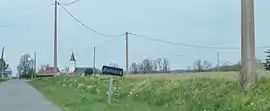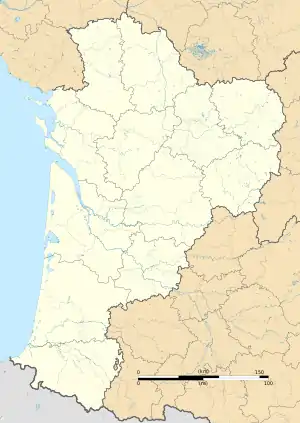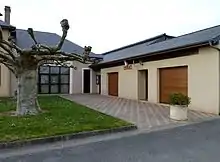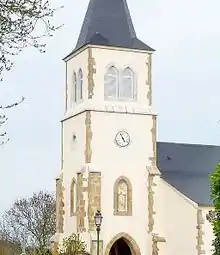Baliracq-Maumusson | |
|---|---|
 Entry to Baliracq | |
Location of Baliracq-Maumusson | |
 Baliracq-Maumusson  Baliracq-Maumusson | |
| Coordinates: 43°32′48″N 0°15′14″W / 43.5467°N 0.2539°W | |
| Country | France |
| Region | Nouvelle-Aquitaine |
| Department | Pyrénées-Atlantiques |
| Arrondissement | Pau |
| Canton | Terres des Luys et Coteaux du Vic-Bilh |
| Intercommunality | Luys en Béarn |
| Government | |
| • Mayor (2020–2026) | Sylvain Sergent[1] |
| Area 1 | 6.06 km2 (2.34 sq mi) |
| Population | 119 |
| • Density | 20/km2 (51/sq mi) |
| Time zone | UTC+01:00 (CET) |
| • Summer (DST) | UTC+02:00 (CEST) |
| INSEE/Postal code | 64090 /64330 |
| Elevation | 120–224 m (394–735 ft) (avg. 132 m or 433 ft) |
| 1 French Land Register data, which excludes lakes, ponds, glaciers > 1 km2 (0.386 sq mi or 247 acres) and river estuaries. | |
Baliracq-Maumusson (French pronunciation: [baliʁak momysɔ̃]; Occitan: Valirac e Maumosson) is a commune of the Pyrénées-Atlantiques department in the Nouvelle-Aquitaine region of south-western France.
Geography
Baliracq-Maumusson is located some 45 km east by north-east of Orthez and 20 km south of Aire-sur-l'Adour. Access to the commune is by the D211 road from Lannecaube in the south which passes through the length of the commune along the eastern side to join the D41 just north of the commune. Access to the village of Baliracq is by Le Moulin road branching from the D211. The commune is mixed forest and farmland.[3]
The Lées river forms the eastern border of the commune as it flows north to join the Adour near Aire-sur-l'Adour. The Gabassot forms the northern border of the commune as it flows east into the Lées. Two other streams rise in the commune and flow into the Lées.[3]
Places and hamlets
Neighbouring communes and villages
Toponymy
According to Michel Grosclaude the name Baliracq probably came from a Latin man's name Valerus with the Gallo-Roman suffix -acum giving the "Domain of Valerus". For Maumusson he proposed a Gascon man's name: the nickname mau meaning "bad" combined with mus meaning "nose" and the suffix -on giving "unfriendly" or "sullen".[11]
The following table details the origins of the commune name and other names in the commune.
| Name | Spelling | Date | Source | Page | Origin | Description |
|---|---|---|---|---|---|---|
| Baliracq | Saint-Félix de Balirac | 10th century | Raymond | 20 | Marca | Village |
| Vallirag | 1100 | Grosclaude | ||||
| Valliracum | 1100 | Grosclaude | ||||
| Balirag | 1443 | Raymond | 20 | Carresse | ||
| Baliracq | 1750 | Cassini | ||||
| Balirac | 1801 | Ldh/EHESS/Cassini | Bulletin des lois | |||
| Balirac | 1863 | Raymond | 20 | |||
| Maumusson | Maumusson | 1750 | Cassini | Village | ||
| Maumussou | 1774 | Raymond | 110 | Terrier | ||
| Castéra | Casterar | 1542 | Raymond | 44 | Reformation | Farm |
Sources:
- Raymond: Topographic Dictionary of the Department of Basses-Pyrenees, 1863, on the page numbers indicated in the table. (in French)[12]
- Grosclaude: Toponymic Dictionary of communes, Béarn, 2006 (in French)[11]
- Cassini: Cassini Map from 1750[13]
- Ldh/EHESS/Cassini: Des villages de Cassini aux communes d'aujourd'hui: Commune data sheet Baliracq-Maumusson, EHESS (in French).
Origins:
- Marca: Pierre de Marca, History of Béarn.[14]
- Carresse:[15]
- Terrier: Terrier of Baliracq, E 177
- Reformation: Reformation of Béarn[16]
History
Paul Raymond noted on page 20 of his 1863 dictionary that Baliracq was a vassal of the Viscounts of Béarn.
The communes of Baliracq and Maumusson were merged in 1828.
Administration
| From | To | Name |
|---|---|---|
| 1792 | 1795 | Jean Sansot |
| 1792 | 1796 | Pierre Sartou |
| 1795 | 1797 | Jean Sarraille |
| 1796 | 1797 | Jacques Monsegu-Castera |
| 1797 | 1798 | Raymond Peyroutel |
| 1797 | 1798 | Pierre Sartou |
| 1798 | 1803 | Jean Sarraille |
| 1798 | 1799 | Pierre Miqueu |
| 1799 | 1805 | Pierre Boucahort |
| 1803 | 1826 | Germain Florence |
| 1805 | 1808 | Pascal Florence |
| 1808 | 1809 | Jean Borie |
| 1809 | 1811 | Jean Manaud |
| 1811 | 1812 | Jean Borie |
| 1812 | 1813 | Fils Lescriba |
| 1813 | 1817 | Jean Borie |
| 1817 | 1821 | Jean Manaud |
| 1821 | 1835 | Jean Fils Manaud |
| 1835 | 1837 | Jean Pierre Sarthou |
| 1837 | 1840 | Adrien Alexandre de Malden |
| 1841 | 1848 | Jean Manaud |
| 1848 | 1882 | Henry Croedey |
| 1882 | 1888 | Pierre Mirande |
| 1888 | 1894 | Jean Sansous |
| 1894 | 1896 | Bernard Castet |
| 1896 | 1900 | Jean Sansous |
| 1900 | 1925 | Charles Sansous |
| 1925 | 1929 | Jacques Cassoulong |
| 1929 | 1933 | Max Croedey |

- Mayors from 1933
| From | To | Name |
|---|---|---|
| 1933 | 1944 | Jacques Cassoulong |
| 1944 | 1944 | Charles Honoré |
| 1944 | 1947 | Jean Barreyat |
| 1947 | 1989 | Albert Sansous |
| 1989 | 2014 | Yvan Duviau |
| 2014 | 2026 | Sylvain Sergent |
Inter-communality
The commune is part of six inter-communal structures:
- the Communauté de communes des Luys en Béarn;
- the SIVU for roads in the Garlin region;
- the SIVU for the Lées and its tributaries;
- the Energy association of Pyrénées-Atlantiques;
- the inter-communal association for the supply of drinking water for Luy-Gabas-Lées;
- the inter-communal association of Five Rivers;
Demography
The inhabitants of the commune are known as Baliracois or Baliracoises in French.[18]
|
| ||||||||||||||||||||||||||||||||||||||||||||||||||||||||||||||||||||||||||||||||||||||||||||||||||||||||||||||||||
| Source: EHESS[19] and INSEE[20] | |||||||||||||||||||||||||||||||||||||||||||||||||||||||||||||||||||||||||||||||||||||||||||||||||||||||||||||||||||
Culture and heritage
Civil heritage
The commune has a number of buildings and structures that are registered as historical monuments:
- A Mill at Baliracq (1764)
 [21]
[21] - A Farmhouse at Baliracq-Bouquehort (19th century)
 [4]
[4] - The Coussié House at Maumusson-Tardan (1742)
 [9]
[9] - The Castéra House at Baliracq-Castéra (1742)
 [5]
[5] - The Lafon House at Maumusson-Crédey (17th century)
 [6]
[6] - The Sansot House at Maumusson-Sansot (19th century)
 [8]
[8] - The Chateau de Milly at Maumusson-Florence (18th century)
 [7]
[7] - Houses and Farms (18th-19th century)
 [22]
[22] - A Fortified Area (Middle Ages)
 [23]
[23] - A Fortified Complex (Prehistoric).
 [24] At a place called Castera the topography has been visibly altered by the hand of man as evidenced by the presence of an ancient fortified complex with major embankments and a circular walkway which is still visible. This could be for high wooden stakes joined together because no stone remains have been found. The works could therefore date to the high Middle Ages although there could be prehistoric remains.
[24] At a place called Castera the topography has been visibly altered by the hand of man as evidenced by the presence of an ancient fortified complex with major embankments and a circular walkway which is still visible. This could be for high wooden stakes joined together because no stone remains have been found. The works could therefore date to the high Middle Ages although there could be prehistoric remains.
Religious heritage

The Parish Church of Saint Peter (11th century)![]() is registered as an historical monument.[25] The Church contains many items that are registered as historical objects:
is registered as an historical monument.[25] The Church contains many items that are registered as historical objects:
- An Altar, Tabernacle, and Statue (19th century)
 [26]
[26] - 2 Statues: Saints Felix and Peter (18th century)
 [27]
[27] - A Tabernacle (17th century)
 [28]
[28] - An Altar Painting: Remission of the keys to Saint Peter (19th century)
 [29]
[29] - An Altar and Retable (1844)
 [30]
[30] - Wood Panelling (1844)
 [31]
[31] - A Wayside Cross (19th century)
 [32]
[32] - An Altar Vase (20th century)
 [33]
[33] - A Monstrance (18th century)
 [34]
[34] - An Altar Candlestick (19th century)
 [35]
[35] - 6 Altar Candlesticks (18th century)
 [36]
[36] - A Thurible
 [37]
[37] - A Celebrant's Chair (18th century)
 [38]
[38] - A Stoup (1822)
 [39]
[39] - A Pulpit (18th century)
 [40]
[40] - A Confessional (18th century)
 [41]
[41] - The Choir Enclosure (1840)
 [42]
[42]
See also
References
- ↑ "Répertoire national des élus: les maires" (in French). data.gouv.fr, Plateforme ouverte des données publiques françaises. 13 September 2022.
- ↑ "Populations légales 2021". The National Institute of Statistics and Economic Studies. 28 December 2023.
- 1 2 3 Google Maps
- 1 2 Ministry of Culture, Mérimée IA00026195 Farmhouse at Baliracq-Bouquehort (in French)
- 1 2 Ministry of Culture, Mérimée IA00026193 Castéra House at Baliracq-Castéra (in French)
- 1 2 Ministry of Culture, Mérimée IA00026192 Lafon House at Maumusson-Crédey (in French)
- 1 2 Ministry of Culture, Mérimée IA00026190 Chateau de Milly at Maumusson-Florence (in French)
- 1 2 Ministry of Culture, Mérimée IA00026191 Sansot House at Maumusson-Sansot (in French)
- 1 2 Ministry of Culture, Mérimée IA00026194 Coussié House at Maumusson-Tardan (in French)
- ↑ Géoportail, IGN (in French)
- 1 2 Michel Grosclaude, Toponymic Dictionary of communes, Béarn, Edicions reclams & Édition Cairn - 2006, 416 pages, p. 99 & 106, ISBN 2-35068-005-3(in French)
- ↑ Topographic Dictionary of the Department of Basses-Pyrenees, Paul Raymond, Imprimerie nationale, 1863, Digitised from Lyon Public Library 15 June 2011 (in French)
- ↑ Cassini Map 1750 – Baliracq-Maumusson
- ↑ Pierre de Marca, Histoire de Bearn, La Veuve Jean Camusat, 1640, 850 pages (in French)
- ↑ Contracts retained by Carresse, Notary of Béarn, Manuscripts from the 15th century in the Departmental Archives of Pyrénées-Atlantiques (in French)
- ↑ Manuscript from the 16th to 18th centuries - Departmental Archives of Pyrénées-Atlantiques (in French)
- ↑ List of Mayors of France (in French)
- ↑ Pyrénées-Atlantiques, habitants.fr
- ↑ Des villages de Cassini aux communes d'aujourd'hui: Commune data sheet Baliracq-Maumusson, EHESS (in French).
- ↑ Population en historique depuis 1968, INSEE
- ↑ Ministry of Culture, Mérimée IA00027435 Mill at Baliracq (in French)
- ↑ Ministry of Culture, Mérimée IA00026189 Houses and Farms (in French)
- ↑ Ministry of Culture, Mérimée IA00026188 Fortified Area (in French)
- ↑ Ministry of Culture, Mérimée IA00026187 Fortified Complex (in French)
- ↑ Ministry of Culture, Mérimée IA00026196 Parish Church of Saint Peter (in French)
- ↑ Ministry of Culture, Palissy IM64001601 Altar, Tabernacle, and Statue (in French)
- ↑ Ministry of Culture, Palissy IM64001600 2 Statues: Saints Felix and Peter (in French)
- ↑ Ministry of Culture, Palissy IM64001599 Tabernacle (in French)
- ↑ Ministry of Culture, Palissy IM64001598 Altar Painting: Remission of the keys to Saint Peter (in French)
- ↑ Ministry of Culture, Palissy IM64001597 Altar and Retable (in French)
- ↑ Ministry of Culture, Palissy IM64001596 Wood Panelling (in French)
- ↑ Ministry of Culture, Palissy IM64001584 Wayside Cross (in French)
- ↑ Ministry of Culture, Palissy IM64001583 Altar Vase (in French)
- ↑ Ministry of Culture, Palissy IM64001582 Monstrance (in French)
- ↑ Ministry of Culture, Palissy IM64001581 Altar Candlestick (in French)
- ↑ Ministry of Culture, Palissy IM64001580 6 Altar Candlesticks (in French)
- ↑ Ministry of Culture, Palissy IM64001579 Thurible (in French)
- ↑ Ministry of Culture, Palissy IM64001578 Celebrant's Chair (in French)
- ↑ Ministry of Culture, Palissy IM64001577 Stoup (in French)
- ↑ Ministry of Culture, Palissy IM64001576 Pulpit (in French)
- ↑ Ministry of Culture, Palissy IM64001575 Confessional (in French)
- ↑ Ministry of Culture, Palissy IM64001574 Choir Enclosure (in French)
External links
- Baliracq-Maumusson on Géoportail, National Geographic Institute (IGN) website (in French)
- Baliracq and Maumußon on the 1750 Cassini Map